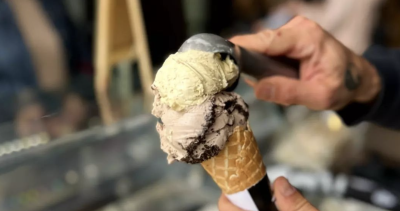Vancouver artists lead comeback of handmade ceramics
The arts of pottery and graphic design have a lot more in common than you think—just ask Vancouver-based ceramist Lindsey Hampton. “Essentially, it’s taking the aspects of design that I like and working with them in 3D form,” she tells the Straight by phone.
A graphic designer by trade, Hampton first stepped up to the potter’s wheel in 2011, when she was looking for a medium in which she could employ her existing skills. After attending a series of ceramics classes gifted by her parents for Christmas, she began introducing her own distinct style into clay.
The curvaceous lamps, dreamy pastel planters, and triangular-handled mugs that Hampton is recognized for today didn’t come easily. But by bucking the trends of yesteryear that dictated ceramics as restrained, ruddy, and largely utilitarian, the artist now finds herself at the centre of a ceramics revolution.
“I like going against what clay wants you to do with it,” she explains. “I like things to not be organic, for things to be quite geometric, to have straight lines.”
Hampton is one of many local ceramists who have helped reignite everyday interest in handcrafted table- and housewares. She credits much of the comeback to the popularity of Instagram, an app that—believe it or not—was relatively unknown only six years ago. These days, the designer regularly shares snaps of her quirky creations with over 25,000 followers.
“It’s so easy to find other people’s work now,” says Hampton. “When I started, that wasn’t a thing.”
Cathy Terepocki, an Ontario-born artist who now calls Yarrow, B.C., home, attributes the comeback of ceramics to the public’s fascination with objects that tell a story. “I think the fact that people are drawn to ceramics right now, in part, has to do with the fact that they’re drawn to things that are made by hand,” she says by phone.
A graduate of the Alberta College of Art and Design, Terepocki has been refining her pottery process for over 10 years. Her wheel-thrown pieces walk the line between old and new, pairing antique elements like weathered cork and natural rope with hanging planters, canisters, and lidded containers.
The affable artist makes her own glazes and coloured slips, which help achieve a layered, almost vintage look in many of her wares. Terepocki is a particular fan of her Pine Creek collection, its name an ode to an Australian town of the same name where she once worked in a gold mine. The soft-hued set features repurposed gilt decals atop vases, bowls, and mugs adorned with geometric patterns.
“I really like the juxtaposition between the speckled clay and gold,” she explains, “because gold is traditionally used as an embellishment on fancy china, and that’s so different from the earthy clay that it’s placed on.”
Maggie Boyd, a Vancouver-based artist who specializes in ceramics, illustration, and sculpture, among other things, occasionally pulls from the past when crafting her decidedly brazen pieces, too. Take her high-contrast, chalkboardlike cups, for example, which are decorated with hand-glazed doodles of intricate Grecian urns.
“I like illustrating lesser versions of these classic pieces of pottery on my work,” she says by phone with a slight chuckle. “I think it’s kind of funny, playful.”
When she’s not channelling ancient Greece, Boyd draws inspiration from a myriad of sources including, but not limited to, art history, gender theory, figurative studies, and feminist politics. Her female demoiselle nudes—typically depicted on short tumblers and mugs in strong, quick strokes—are especially striking.
For Boyd, handmade tableware simply serves as an out-of-the-box canvas—a concept she’s also seen other ceramists adopting. “I think what’s happening…is this fusing of the art piece and the functional object,” she muses. “And the space between them is becoming a little bit blurry.”
Like Hampton and Terepocki, Boyd notes that her work is constantly evolving. And though she acknowledges the roles of Pinterest and Instagram in ceramics’ recent resurgence (“These are 3-D objects we’ve flattened out again,” she explains), the artist is confident that the craft carries a staying power absent in other so-called social-media trends.
“People’s interests have been sparked,” she says, “and I guess they understand that this useful beauty is actually a pretty spectacular thing to engage with.”















Comments